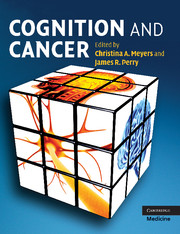Book contents
- Frontmatter
- Contents
- List of contributors
- Preface
- Section 1 Cognition and the brain: measurement, tools, and interpretation
- Section 2 Effects of cancer and cancer treatment on cognition
- 7 Biological bases of radiation injury to the brain
- 8 Cognitive dysfunction related to chemotherapy and biological response modifiers
- 9 Effect of hormones and hormonal treatment on cognition
- 10 Low-grade gliomas
- 11 High-grade gliomas
- 12 Brain metastases
- 13 Primary central nervous system lymphoma
- 14 Childhood brain tumors
- 15 Neurofibromatosis
- 16 Hematological malignancies
- 17 Paraneoplastic disorders
- 18 Symptomatic therapies and supportive care issues
- 19 Animal models and cancer-related symptoms
- Section 3 Interventions and implications for clinical trials
- Index
- Plate section
- References
16 - Hematological malignancies
Published online by Cambridge University Press: 13 August 2009
- Frontmatter
- Contents
- List of contributors
- Preface
- Section 1 Cognition and the brain: measurement, tools, and interpretation
- Section 2 Effects of cancer and cancer treatment on cognition
- 7 Biological bases of radiation injury to the brain
- 8 Cognitive dysfunction related to chemotherapy and biological response modifiers
- 9 Effect of hormones and hormonal treatment on cognition
- 10 Low-grade gliomas
- 11 High-grade gliomas
- 12 Brain metastases
- 13 Primary central nervous system lymphoma
- 14 Childhood brain tumors
- 15 Neurofibromatosis
- 16 Hematological malignancies
- 17 Paraneoplastic disorders
- 18 Symptomatic therapies and supportive care issues
- 19 Animal models and cancer-related symptoms
- Section 3 Interventions and implications for clinical trials
- Index
- Plate section
- References
Summary
Introduction
Development of effective treatments for cancer has significantly improved survival rates for hematological cancer patients. For example, in 1964 the 5-year survival rate for acute lymphoblastic leukemia (ALL) was 3%; in 1995–2001, it was 86% (Leukemia and Lymphoma Society, 2005; Ries et al., 2005). However, survival is often associated with negative effects on cognitive functioning which interfere with patients' current and future functional status.
In patients with hematological malignancies, risk factors for cognitive disorders are present during all stages of the disease and treatment process. Risk factors include cancer treatments, anemia and fatigue, immune response activity, central nervous system (CNS) involvement of the primary malignancy (especially in the case of ALL), disease and treatment complications affecting the CNS such as infection, hemorrhage, degeneration and leukoencephalopathy, and cognitive and psychiatric disorders that occur in the general population independent of having cancer.
Information on the long-term neuropsychological effects of cancer therapies is an important component of not only the informed consent process, but also the treatment planning process. In the risk-benefit analysis for selecting treatment, survival rates alone may be insufficient because some treatments are associated with significant depletion of cognitive and functional abilities.
Neurological Complications Independent of Cognitive Deficits
Neurological complications, independent of cognitive complaints, are common in hematological cancer patients. Neurological complications have been reported in 11%–65% of hematopoietic stem cell transplantation (HSCT) patients (Faraci et al., 2002; Gallardo et al., 1996; Graus et al., 1996; Harder et al., 2002; Sostak et al., 2003) and may be the main cause of death in 8.5%–26% of recipients (Faraci et al., 2002; Gallardo et al., 1996; Snider et al., 1994; Sostak et al., 2003).
- Type
- Chapter
- Information
- Cognition and Cancer , pp. 228 - 238Publisher: Cambridge University PressPrint publication year: 2008



